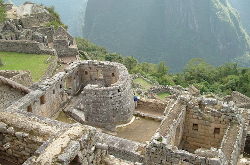페루 마추피추

A “bucket list” is a list of things you want to do before you die. The term “bucket list” comes from an old English expression “kick the bucket.” This idiom is lighthearted way of talking about death.
“The Bucket List” is the title of a 2007 movie starring actors Jack Nicholson and Morgan Freeman. It tells the story of two aging men who want to have some crazy adventures before they die.
Visiting the Inca ruins at Machu Picchu should be high on anyone’s bucket list. Buried deep in the Peruvian Andes, Machu Picchu is an icon, or symbol, of Inca civilization. Far away, tropical and mysterious, it is the ultimate exotic travel destination.
For many, a trip to Machu Picchu starts in Lima, the capital of Peru. Most tourists skip this dry coastal city of 10 million, but it is worth seeing for a few days. It is a “foodie” paradise with world-class restaurants.
Lima’s historic center is lively and easy to walk. A highlight is the 17th-century Monastery of San Francisco, with its famous library and catacombs. Before Lima’s cemetery opened in 1808, the bodies of the dead were left in a space under the church. Visitors can see the catacombs, where the bones of 25,000 people lie.
To the south of the historic center is Miraflores, a modern seaside district. Larcomar is a shopping center built into the side of a cliff. Here is a great place to try Peru’s famous seafood dish called ceviche, which is fish cooked in vinegar or citrus juice. Then watch the sunset over the Pacific Ocean.
After a few days in Lima, it's time to fly deep into the Peruvian Andes to the city of Cuzco. This historic city of 300,000 was once the capital of the Inca Empire.
At 3,400 meters, Cuzco is one of the highest cities in the world. Visitors usually suffer from altitude sickness. A simple task like climbing a flight of stairs can leave you out of breath. The local people recommend chewing coca leaves to help fight altitude sickness.
Leave your map behind and wander Cuzco’s narrow cobblestone streets. There are enough galleries, museums, churches, and archaeological sites to keep you busy for several days.
From Cuzco, you can take a five-day hike on the Inca Trail to Machu Picchu. Most people, however, use a combination of train and bus to reach Machu Picchu.
About two hours northwest of Cuzco is the small Inca village of Ollantaytambo. This historic stone village is home to about 700 people. Ancient Inca fortifications look down on the village from steep treeless mountains. It was here where the Inca leader Manco fought the Spanish conquerors in the 16th century.
The train ride to the base of Machu Picchu is one of the most scenic in the world. The train winds alongside a muddy, roaring river. As the train descends into the tropical forest, the weather turns hot and humid. Machu Picchu is actually 450 meters below Cuzco. It is noticeably easier to breathe. From the final train stop at Aguas Calientes, visitors can hike or ride a bus up to Machu Picchu.
Machu Picchu is one of the great man-made wonders in the world. It was built around 1450 for the Inca emperor Pachacuti. A complex network of stone terraces line the steep mountainside. The terraces were used for agriculture. Temples made of stones weighing up to 20 tons are perfectly joined without the use of mortar. The complex was built with special attention to the position of the sun and the moon. Amazingly, the Incas built Machu Picchu without the use of wheels or horses.
The Incas left the site a few years after the arrival of the Spanish conquerors in the 1500s. The Spanish robbed and destroyed numerous native holy sites throughout Peru. Fortunately, they never found Machu Picchu. For 461 years, Machu Picchu was unknown to Western civilization.
In 1911, American historian Hiram Bingham was traveling through Peru. A local farmer led Bingham to the ruins of Machu Picchu, which means “old peak” in the local Quechua language.
Bingham wrote a popular book that introduced Machu Picchu to the Western world. He thought he had found the “lost city of the Incas.” But most experts today think the site was a citadel and a summer vacation home for Inca emperors. Exactly how and why Machu Picchu was built remains a mystery.
Today, Machu Picchu is the top tourist attraction in Peru. It is so popular that the Peruvian government has limited access to the site to 2,500 visitors per day.
It can take several days to get to Machu Picchu, but visitors can only stay for a few hours. For many tourists, Machu Picchu is more of a journey than a destination. And the memories of the short visit can last a lifetime.
Maria Cecilia La Puente is an education administrator in Cuzco. She remembers visiting Machu Picchu for the first time as a teenager. “You feel different, you know, in a different way. It’s like when you are at the top, (and) you can feel that you are the owner of the world. Going climbing and finally arriving at the top, it’s like fantastic.”
Machu Picchu is just one of Peru’s many wonders. Peruvians take great pride in their nation’s rich cultural heritage and natural beauty. Machu Picchu might be the most famous place in Peru, but it is only the beginning.

